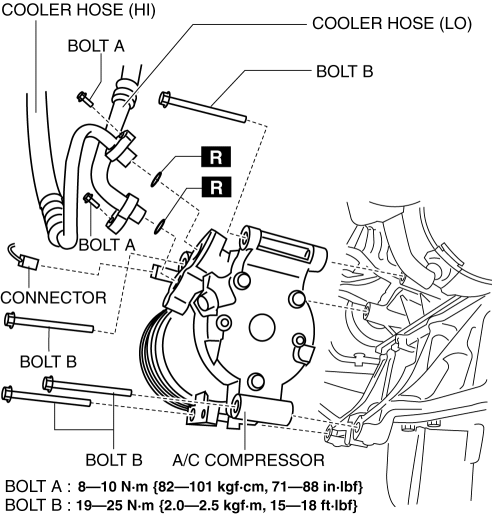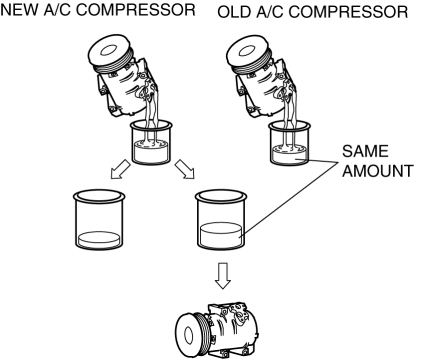Mazda CX-5 Service & Repair Manual: A/C Compressor Removal/Installation
1. Disconnect the negative battery cable..
2. Discharge the refrigerant..
3. Remove the front under cover No.2..
4. Remove the drive belt..
5. Disconnect the connector.

6. Remove bolts A.
CAUTION:
-
If moisture or foreign material enters the refrigeration cycle, cooling ability will be lowered and abnormal noise or other malfunction could occur. Always plug open fittings immediately after removing any refrigeration cycle parts.
7. Remove the cooler hose (LO)..
8. Remove the cooler hose (HI)..
9. Remove bolts B.
10. Remove the A/C compressor. Do not allow compressor oil to spill..
11. Install in the reverse order of removal.
12. Perform the refrigerant system performance test..
A/C Compressor Installation Note
CAUTION:
-
Due to the high moisture-absorption characteristics of the compressor oil, it may absorb moisture if left over a long period of time thereby negatively affecting A/C operation. Drain the compressor oil and refill within 10 min. of each other.
1. Rotate the new A/C compressor shaft six to eight revolutions while pouring refrigerant oil in a clean measuring container. Use this refrigerant oil to refill new compressor. Do not allow refrigerant oil to become contaminated.
2. Rotate old A/C compressor shaft six to eight revolutions while pouring refrigerant oil in a separate, clean measuring container.
3. Compare those oil amounts. The amount of the oil drained from the new A/C compressor should be greater than the old one.
4. Pour the same amount oil drained from the old A/C compressor back into the new A/C compressor.

-
A/C compressor oil type
-
FD46XG
-
A/C compressor oil sealed volume (approx. quantity)
-
100 ml {100 cc, 3.38 fl oz}
 A/C Compressor Control [Full Auto Air Conditioner]
A/C Compressor Control [Full Auto Air Conditioner]
Purpose
The A/C compressor control switches the A/C compressor on/off according to
the vehicle environment.
Function
The A/C compressor control turns the A/C compressor on/off b ...
 A/C Cut Off Control [Skyactiv G 2.0]
A/C Cut Off Control [Skyactiv G 2.0]
Outline
Controls the A/C operation by switching the A/C relay ON/OFF at the optimal
timing according to engine operation conditions. Acceleration performance and
A/C compressor reliabilit ...
Other materials:
Map Light Bulb Removal/Installation
Front Map Light
1. Disconnect the negative battery cable..
2. To prevent scratches or damage, affix protective tape to the position shown
in the figure.
CAUTION:
If a flathead screwdriver is inserted into the gap between the front map
light and lens, the front map light could inter ...
Rear Seat
Split Folding
The seatbacks can be folded down to provide more space in the luggage compartment.
WARNING
Tightly secure cargo in the luggage compartment when it is transported
with the seatbacks folded down:
Driving without tightly securing cargo and luggage is dangerous as it could move
and ...
Automatic Transaxle Fluid (ATF) Adjustment [Fw6 A EL, Fw6 Ax EL]
CAUTION:
Only adjust the ATF level when the ATF temperature is 45—55 °C {113—131 °F}.
If the ATF level is incorrect, it could damage the transaxle.
Do not add ATF over the specification. Otherwise, the transaxle performance
could be reduced and ATF could leak.
1. Re ...
